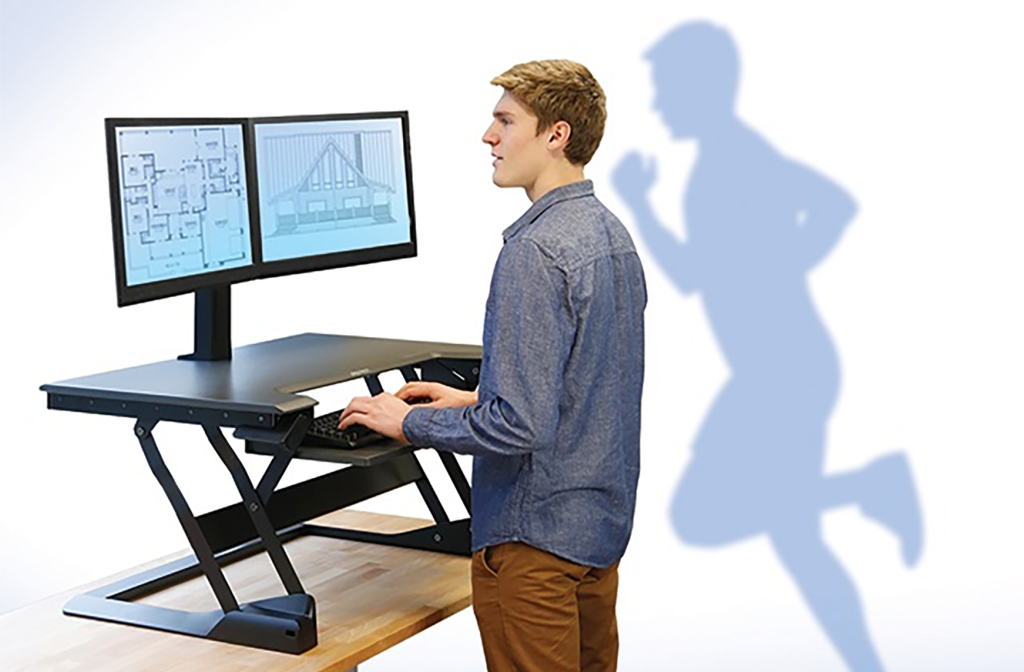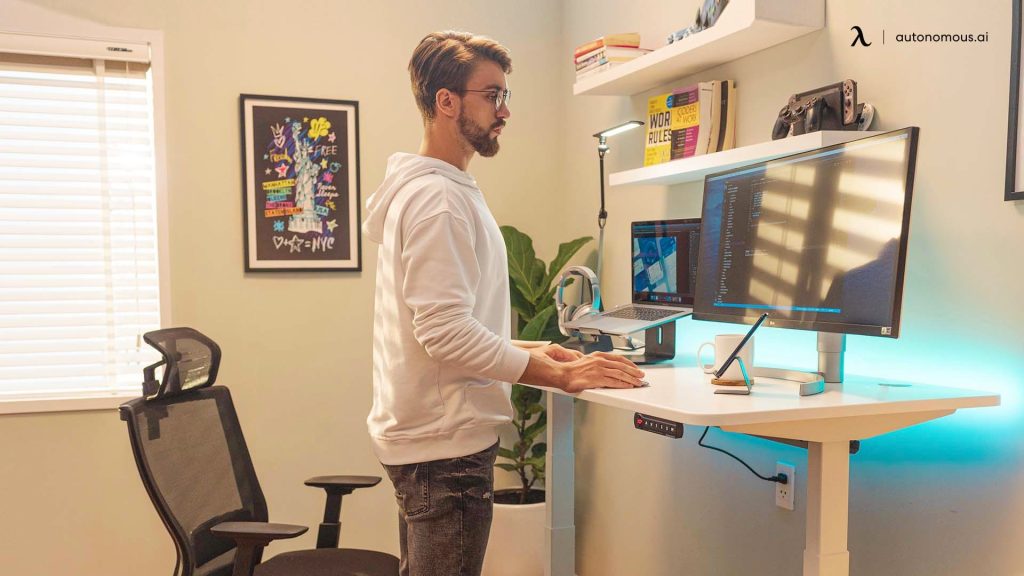No products in the cart.
Height Adjustable Desks, Standing Desk Converters, Standing Desks
Choosing the Right Standing Desk for You
Finding the perfect standing desk that suits your needs and preferences can be a daunting task. With an increasing number of options available in the market, it’s important to consider various factors to ensure you make the right choice. This article will explore the different types of standing desks, their advantages, and the key factors to consider when selecting the right one for you. Whether you’re looking to improve your posture, increase productivity, or simply want to switch between sitting and standing throughout the day, this article will guide you in finding the perfect standing desk that perfectly fits your lifestyle.
Considerations before Choosing a Standing Desk
Height Adjustability
When choosing a standing desk, one of the most important factors to consider is its height adjustability. Since each individual’s height is different, it’s crucial that the desk can be easily adjusted to the proper height for comfortable use. Look for a standing desk that provides a wide range of height adjustments to accommodate people of varying heights.
Desk Size
Another consideration is the size of the desk. It should be large enough to accommodate all of your work essentials, such as your computer monitor, keyboard, and other accessories. Measure the available space in your workspace before making a decision to ensure that the desk will fit without overcrowding the area.
Weight Capacity
The weight capacity of a standing desk is an important consideration, especially if you have multiple monitors or heavy equipment that you need to place on the desk. Make sure that the desk can support the weight of your equipment without compromising its stability and durability.
Stability and Durability
Stability and durability are crucial factors, as you don’t want your standing desk to wobble or collapse while you are working. Look for desks made of high-quality materials that can provide stability and withstand daily use. Consider desks with crossbars or reinforced support to enhance stability.
Ergonomics
Ergonomics play a significant role in ensuring your comfort and well-being while using a standing desk. Look for desks that offer ergonomic features such as adjustable keyboard trays, monitor arms, and cable management solutions. These ergonomic features will help you maintain a natural posture and reduce strain on your wrists, neck, and back.
Types of Standing Desks
Manual Standing Desks
Manual standing desks are operated by a hand crank or lever system. They offer a more cost-effective option compared to electric desks and allow you to adjust the height manually. While they may require more effort and time to adjust, they can still provide the benefits of a standing desk at a lower price point.
Electric Standing Desks
Electric standing desks are operated by an electric motor, allowing for effortless height adjustments. With just the push of a button, you can easily switch between sitting and standing positions. While they may be more costly compared to manual desks, the convenience of electric height adjustment can make them a worthwhile investment.
Hybrid Standing Desks
Hybrid standing desks combine the convenience of electric height adjustment with the affordability of a manual desk. These desks typically have an electric motor for adjusting the height vertically, while the user can manually adjust the desk’s tilt or angle. Hybrid desks offer flexibility and customization options that cater to different work requirements.
Desktop Standing Converters
Desktop standing converters are an excellent option if you already have a traditional sitting desk and want to add standing functionality. These converters sit on top of your existing desk and can be raised or lowered to your desired height. They are a more cost-effective solution compared to purchasing a full standing desk and can easily be moved or adjusted to fit your needs.
Features to Look for in a Standing Desk
Ease of Height Adjustment
A standing desk should have a smooth and effortless height adjustment mechanism. Look for desks that can be easily adjusted to your desired height without requiring too much physical effort. This feature will allow you to seamlessly switch between sitting and standing positions throughout the day.
Memory Presets
Some standing desks come with memory presets that allow you to program specific height settings for easy and quick adjustments. With the push of a button, you can save and recall your preferred standing and sitting heights. This feature is especially useful if multiple people will be using the desk and have different height preferences.
Noise Level
Consider the noise level of the standing desk, especially if you work in a shared workspace or have noise restrictions. Electric standing desks can produce a certain level of noise when adjusting the height, so it’s important to choose a desk with a quiet motor to minimize any distractions.
Assembly Process
Before making a purchase, consider the assembly process of the standing desk. Some desks may require extensive assembly and tools, while others may come pre-assembled or with easy-to-follow instructions. If you are not comfortable with assembling furniture, it may be beneficial to choose a desk that offers professional assembly services.
Cable Management
A standing desk with effective cable management solutions can help keep your workspace organized and reduce clutter. Look for desks with built-in cable trays, grommet holes, or other cable management options to securely route and hide cables. This will not only improve the overall aesthetics but also prevent cables from tangling and becoming a safety hazard.
Budget and Pricing
Setting a Budget
Setting a budget for your standing desk is essential to narrow down your options. Determine how much you are willing to spend based on your needs and preferences. Keep in mind that while some standing desks may have a higher upfront cost, they can provide long-term benefits for your health and productivity.
Additional Costs
Consider any additional costs that may be associated with the standing desk. This could include accessories, such as an anti-fatigue mat, monitor arms, or keyboard trays, which can enhance your overall experience. Additionally, factor in any costs for shipping, assembly services, or extended warranties to get a comprehensive understanding of the total cost.
Value for Money
When evaluating different standing desks, consider the value for money they offer. Look beyond just the price tag and assess the quality, features, durability, and overall benefits that the desk provides. Choosing a standing desk that offers excellent value for money ensures that you are making a worthwhile investment in your health and work productivity.
Health Benefits of Using a Standing Desk
Reduced Risk of Obesity and Weight Gain
Using a standing desk can help combat sedentary behavior and contribute to weight management. Standing burns more calories than sitting, and prolonged sitting has been linked to an increased risk of obesity and weight gain. Incorporating standing into your work routine with a standing desk can help you maintain a healthy weight and overall well-being.
Improved Blood Circulation
Sitting for extended periods can lead to poor blood circulation, which can contribute to various health issues, such as deep vein thrombosis (DVT) and cardiovascular problems. Standing stimulates blood flow and helps prevent these circulation problems. By using a standing desk, you can promote better blood circulation throughout your body.
Better Posture
Sitting for prolonged periods can negatively impact your posture, leading to back, neck, and shoulder pain. Standing desks can encourage better posture by promoting an upright position and reducing the strain on your spine. With a properly adjusted standing desk, you can maintain a neutral posture and alleviate potential musculoskeletal issues.
Increased Productivity
Standing desks have been associated with increased productivity and focus. Standing can boost energy levels and help combat lethargy, especially during long work hours. Standing also promotes better concentration and engagement, leading to improved work performance and efficiency. Utilizing a standing desk can positively impact your productivity throughout the day.
Considerations for Work Environment
Space Availability
Before purchasing a standing desk, assess the available space in your work environment. Consider the dimensions of the desk and ensure that it fits comfortably without overcrowding the area. If you have limited space, consider compact standing desks or desktop converters that can efficiently utilize the available space.
Aesthetics and Design
The design and aesthetics of a standing desk can play a role in creating a visually appealing work environment. Choose a desk that complements your existing office decor and personal style. Standing desks come in various styles, materials, and finishes, allowing you to find one that aligns with your aesthetic preferences.
Noise Restrictions
If you work in a shared space or have noise restrictions, it’s important to consider the noise level of the standing desk. Electric standing desks may produce some noise during height adjustments, so opt for desks with quiet motors to minimize disturbances. Consider desks with solid construction and stability to reduce any potential noise from vibrations.
Power Source Availability
Electric standing desks require a power source for their height adjustment mechanism. Ensure that you have access to a nearby power outlet or consider desks with battery-powered options if electrical outlets are limited. This will ensure that you can conveniently operate the desk without any constraints based on power availability.
Evaluating User Feedback and Reviews
Researching Online Reviews
Before making a final decision, research online reviews from verified customers. Reading reviews can provide valuable insights into the pros and cons of different standing desks. Look for patterns and common feedback to gauge the overall customer satisfaction and durability of the desks you are considering.
Considering User Ratings
User ratings can be an additional indicator of the quality and performance of a standing desk. Look for desks with high ratings and positive feedback to ensure that you are considering products that have been well-received by other users. Take note of any negative ratings or recurring issues to make an informed decision.
Seeking Expert Opinions
In addition to user feedback, consider seeking expert opinions from reputable sources, such as ergonomic specialists or professionals in the field. They can provide valuable insights into the ergonomics, functionality, and overall suitability of different standing desks based on their expertise and experience. Expert opinions can help validate your choices and provide additional guidance.
Testing and Trying Out Standing Desks
Visiting a Showroom
If possible, visit a showroom or furniture store that displays various standing desks. This will allow you to physically test and experience the desks before making a purchase. Assess the ease of height adjustment, stability, and overall comfort to determine which desk best suits your needs. Showrooms provide an opportunity to make an informed decision based on firsthand experience.
Trial Periods and Return Policies
Many standing desk manufacturers offer trial periods or return policies to ensure customer satisfaction. Take advantage of these options if available and try out the desk in your own work environment. This will allow you to assess the desk’s compatibility with your workflow, comfort, and overall usability. Take note of any return policies or warranties to protect your investment.
Accessories and Add-ons for Standing Desks
Anti-Fatigue Mats
Anti-fatigue mats are specifically designed to provide cushioning and support for your feet while standing. They can help reduce fatigue and discomfort caused by long periods of standing. Consider adding an anti-fatigue mat to your standing desk setup to enhance your overall comfort and promote better posture.
Monitor Arms and Mounts
Monitor arms and mounts allow you to adjust the height and angle of your computer monitor to optimize your viewing experience. These accessories can help reduce strain on your neck and eyes by allowing you to position the monitor at eye level. Choose monitor arms that are compatible with your monitor size and weight.
Keyboard Trays
Ergonomic keyboard trays can improve the ergonomics of your standing desk setup by positioning your keyboard and mouse at a comfortable height and angle. Look for trays with adjustable tilt and height settings to ensure proper alignment with your wrists and minimize the risk of repetitive strain injuries.
Cable Management Solutions
Cable management is essential for maintaining a tidy and organized workspace. Invest in cable management solutions, such as cable trays, clips, or sleeves, to keep your cables organized and prevent them from tangling or causing hazards. Keeping your cables neatly arranged can improve the overall aesthetics and functionality of your standing desk setup.
Conclusion
Choosing the right standing desk requires careful consideration of various factors, including height adjustability, desk size, weight capacity, stability, ergonomics, and budget. Assessing your work environment, understanding the different types of standing desks available, and exploring user feedback and reviews will guide you towards making an informed decision. Remember to test standing desks in person whenever possible and consider accessories like anti-fatigue mats, monitor arms, keyboard trays, and cable management solutions to enhance your standing desk experience. By prioritizing these considerations, you can find a standing desk that promotes a healthier and more productive work routine.






